A man surnamed Huang enrolled his boy in school in Sanya, Hainan Province, China. But the boy’s teacher, after receiving no response to his question in Mandarin as to which student was named A Hao, decided school was no place for a child who didn’t speak Mandarin. The youngster could return after mastering Mandarin, the teacher said. (“Xuéhuì Pǔtōnghuà zàilái shàngxué ba.”)
Although the school has defended the indefinite suspension of the small child, citing “safety concerns,” it doesn’t seem to have many supporters of this action. Mr. Huang is considering a lawsuit against the school, and the district’s authorities have launched an investigation.
Mandarin is not even the native language for that part of China. The linguistic situation on Hainan is similar to that in Taiwan: most of the native population grew up speaking Hoklo or a non-Sinitic “minority” language, which are all suppressed in favor of Mandarin, whose speakers have poured in relatively recently. Although the active suppression of non-Mandarin languages in Taiwan is no longer as active as before or as the situation remains in China, indirect suppression remains very much in force.
Huáng xiānsheng xiàng jìzhě fǎnyìng, yóuyú gōngzuò xūyào, tā jiāng qī’ér cóng Hǎinán Shěng Wànnìng Shì bāndào Sānyà Shì Ānyóu Dìqū. Tā dǎsuan jiāng háizi sòngdào fùjìn de Ānyóu Xiǎoxué dúshū, dànshì háizi yīn bù huì Pǔtōnghuà ér bèi lèlìngtuìxué.
Qǐyīn: háizi zǒucuò jiàoshì
Huáng xiānsheng duì jìzhě shuō, háizi dì-yī tiān kāixué huílai hòu jiù duì tā shuō: “Bàba, wǒ zǒucuò jiàoshì le, lǎoshī jiào nǐ míngtiān qù yīxià xuéxiào.”
Dì-èr tiān, Huáng xiānsheng láidào xuéxiào hòu cái dézhī wèntí de yánzhòngxìng. Xiàozhǎng gàosu tā, tā de háizi yīn zǒu cuòle jiàoshì, ràng quán xuéxiào lǎoshī wèicǐ xūjīng yī chǎng. Bānzhǔrèn liǎng cì dào xuésheng qián bān xúnwèn něige xuésheng jiào Ā Hào, dànshì Ā Hào zuòzài jiàoshì lǐ què méiyǒu huídá. Bānzhǔrèn duì Huáng xiānsheng shuō, “Wǒ yī dào xuéxiào, Lóng lǎoshī jiù gēn wǒ shuō, ràng nǐ de háizi huíjiā ba, xuéhuì Pǔtōnghuà zàilái shàngxué ba.”
Huáng xiānsheng shuō, tā de háizi yuánlái zài lǎojiā dúguò yī niánjí, chéngjì bùcuò, dàn zài jiāxiāng jiǎng de duō shì Hǎinán huà, yīncǐ, tā de háizi shuō Pǔtōnghuà de nénglì hěn chà, zhǐnéng jiǎndān de tīngdǒng yīdiǎn.
Jiāzhǎng: yào dǎ guānsi tǎo gōngdào
Huáng xiānsheng duì jìzhě shuō, tā de xiǎohái yòu méiyǒu fàn cuòwu, méiyǒu shénme guòcuò, jiù yīnwèi bù huì Pǔtōnghuà, zǒu cuòle jiàoshì, jiù zhèyàng bèi chéngfá, zhè tài bù gōngpíng le. Jìrán xuéxiào yǐ tōngguò kǎoshì tóngyì qí bàomíng, jiù xiāngdāngyú shuāngfāng qiān le héyuē, xuéxiào bùnéng dānfāngmiàn huǐyuē.
Huáng xiānsheng chēng, wèile háizi de dúshū quánlì, tā jiāng dào jiàoyù zhǔguǎn bùmén tóusù, bìng dǎsuan jiāng xuéxiào gào shàng fǎtíng, wèi háizi tǎo huí gōngdào.
Xuéxiào: shìwéi ānquán kǎolǜ
Jìzhě jiù Huáng xiānsheng fǎnyìng de qíngkuàng láidào Ānyóu Xiǎoxué héshí qíngkuàng. Gāi xuéxiào Shàn xiàozhǎng jiēshòu jìzhě cǎifǎng shí chēng, gāi xuésheng bù shì běnxiào fànwéi nèi de xuésheng, yòu tīngbudǒng Pǔtōnghuà, bù huì yǔ rén jiāoliú. Shàn xiàozhǎng shuō, ràng gāi xuésheng tuìxué de zhíjiē yuányīn shì, gāi xuésheng zǒu cuòle jiàoshì, quán xuéxiào shī-shēng dàochù zhǎo, tā què zuòzài xué; qián bān de jiàoshì lǐ yī shēng bù kēng, xià de quán xuéxiào lǎoshī xūjīng yī chǎng. Shàn xiàozhǎng biǎoshì, rúguǒ bù fāshēng zhèyàng de shì, xuéxiào jiù bù huì lèlìng qí tuìxué le, zhè zhǔyào shì cóng ānquán fāngmiàn lái kǎolǜ de.
Jiàoyùjú: xuéxiào zuòfǎ bùduì
Jiù Huáng xiānsheng fǎnyìng qí háizi yīn bù huì Pǔtōnghuà ér bèi lèlìngtuìxué yīshì, jìzhě cǎifǎng le Sānyà Shì Jiàoyùjú fù júzhǎng zhāng wèi lán. Zhāng fù júzhǎng shuō, xuéxiào de zuòfǎ kěndìng bùduì, bùnéng yīnwèi xuésheng bù huì shuō Pǔtōnghuà jiù lèlìngtuìxué. Háizi bù huì Pǔtōnghuà, dào xuéxiào zhèyàng de huánjìng zhōng jiù kěyǐ xuéhǎo Pǔtōnghuà, zhè yěshì yī zhǒng xuéxí de guòchéng.
Zhāng fù júzhǎng shuō, huì pài yǒuguān rényuán yǔ xuéxiào xiétiáo, zélìng Ānyóu Xiǎoxué gǎizhèng cuòwù, jìxù ràng Huáng xiānsheng de háizi lái shàngxué.
Lǜshī: háizi yǒu dúshū quánlì
Jiù gāi xuésheng bèi xuéxiào lèlìngtuìxué yīshì, jìzhě cǎifǎng le Sānyà Shì yán bì xìn lǜshī shìwùsuǒ lǜshī chén chuān Huà xiānsheng. Chén lǜshī shuō, gēnjù wǒguó wèichéngniánrén bǎohù fǎ hé jiǔ nián zhì yìwù jiàoyùfǎ, wèichéngniánrén tóngyàng xiǎngyǒu shòu jiàoyù de quánlì, xuéxiào, shèhuì, jiātíng yǒu yìwù ràng wèichéngniánrén dúshū. Chén lǜshī rènwéi, Ānyóu Xiǎoxué de zuòfǎ shì wéifǎn yǒuguān fǎlǜ fǎguī de, xuésheng jiāzhǎng wánquán kěyǐ tōngguò fǎlǜ tújìng wèi qí háizi tǎo huí gōngdào.

 The latest issue of Science features an article on a stone slab found in Veracruz, Mexico. Scholars have identified the inscriptions on the stone — tentatively dated to at least 900 B.C.E. — as the earliest writing yet found in the Americas.
The latest issue of Science features an article on a stone slab found in Veracruz, Mexico. Scholars have identified the inscriptions on the stone — tentatively dated to at least 900 B.C.E. — as the earliest writing yet found in the Americas. 